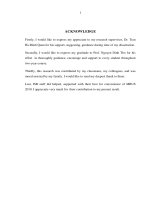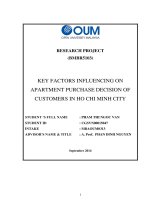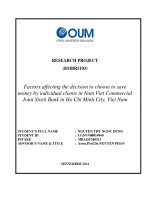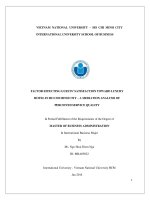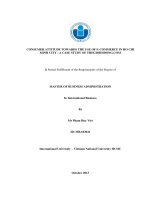FACTORS AFFECTING BEHAVIORAL INTENTIONS TOWARD MOBILE BANKING USAGE A STUDY OF BANKING CUSTOMERS IN HO CHI MINH CITY
Bạn đang xem bản rút gọn của tài liệu. Xem và tải ngay bản đầy đủ của tài liệu tại đây (1.46 MB, 72 trang )
UNIVERSITY OF ECONOMICS HO CHI MINH CITY
International School of Business
Nguyen Khac Duy
FACTORS AFFECTING
BEHAVIORAL INTENTIONS TOWARD
MOBILE BANKING USAGE:
A STUDY OF BANKING CUSTOMERS
IN HO CHI MINH CITY
ID: 60340102
MASTER OF BUSINESS (Honours)
SUPERVISOR: Dr. Nguyen Thi Nguyet Que
Ho Chi Minh City – Year 2012
[ 2 ]
ACKNOWLEDGEMENT
At the first of my thesis, I would like to thank all those people who made
this thesis possible and an unforgettable experience for my studying.
Foremost, I would like to express my sincere gratitude to my supervisor,
Dr. Nguyen Thi Nguyet Que, for the continuous support of my MBUS study and
research, for her patience, motivation, enthusiasm, and immense knowledge. Her
guidance helped me in all the time of research and writing of this thesis.
Besides my supervisor, I would like to thank the rest of my thesis
committee: Prof. Nguyen Dong Phong, Prof. Nguyen Dinh Tho, and Dr. Tran Ha
Minh Quan, for their encouragement, insightful comments, and hard questions.
I thank my classmates in ISB MBUS 2010 encourage and support me
complete this thesis. Completing this work would have been all the most difficult
were it not for the support and friendship provided by the members of University
of Economics Ho Chi Minh City - International School of Business.
Last but not the least; I would like to thank my family. I must express my
gratitude to Nguyen Thi Hong Hiep, my wife, for her continued support and
encouragement. I also wish thank all those people who spent through their time
and generous support made this thesis project a dream come true.
Ho Chi Minh City, December 18, 2012
NGUYEN KHAC DUY
[ 3 ]
ABSTRACT
Mobile phones with banking technology are becoming more readily
available in Vietnam. Similarly, many financial institutions and mobile phone
service providers are teaming up to provide several banking services to
customers via the mobile phone. However, the number of people who choose to
adopt or use such technologies is still relatively low. Therefore, there is a need to
assess the acceptance of such technologies to establish factors that hinder or
promote customer‟s intention to use mobile banking (MB). Technology
Acceptance Model (TAM) and Theory of Planned Behaviour (TPB) are the base
models in order to investigate the customers‟ intention to use mobile banking
services in Ho Chi Minh City (HCMC). A questionnaire with five-point Likert
scale is survey to 400 target respondents. This research combines the variables
(1) “perceived usefulness”, (2) “perceived ease of use”, (3) “attitude”, (4)
“subjective norm”, and (5) “Perceived behavioral control” in a proposed model
to reflect consumer‟s intention to use mobile banking. Results indicate that
perceived usefulness, perceived ease of use, subjective norm, and perceived
behavioral control are significant with respect to the customer‟s intention to use
mobile banking services. In constrast with previous studies, attitude was not
significant in explaining mobile banking adoption. In summary, perceived
behavioral control contributes the most in explaining the factor of intention to
use mobile banking. The results of the data analysis contributes to the body of
knowledge by demonstrating that the above factors are critical in intention to use
mobile banking in a developing country context. The implications of the results
form a good basis for providing practical recommendations to leaders of
commercial banks, and directions for further work.
[ 4 ]
TABLE OF CONTENTS
ACKNOWLEDGEMENT 2
ABSTRACT 3
LIST OF FIGURES 7
LIST OF TABLES 7
CHAPTER 1: INTRODUCTION 8
1.1. Research background 8
1.2. Overview of electronic banking market in Ho Chi Minh City 9
1.2.1. E-banking services 9
1.2.2. Advantages of e-banking services 11
1.2.3. Difficulties in implementing e-banking services 12
1.3. Problem statement 13
1.4. Research objective 14
1.5. Research scopes and limitations 15
1.6. Research implications 15
1.7. Thesis structure 16
1.8. Summary 17
CHAPTER 2: LITERATURE REVIEW 18
1.1. Theoretical background 18
1.1.1. Technology Acceptance Model 18
1.1.2. Theory of Planned Behavior 19
1.2. Research model and hypotheses 20
1.3. Summary 24
CHAPTER 3: METHODOLOGY 25
[ 5 ]
3.1. Research design 25
3.2. Development of questionnaire 26
3.2.1. Measurement scales 26
3.2.1.1. Measure of Perceived usefulness and Perceived ease of use 26
3.2.1.2. Measure of Attitude 27
3.2.1.3. Measure of Subjective norms 28
3.2.1.4. Measure of Perceived Behavioural Control 29
3.2.1.5. Measure of Intention to use mobile banking 29
3.2.2. Draft questionnaire 30
3.3. Pilot study 30
3.4. Sample method 31
3.5. Questionnaire administration 32
3.6. Data analysis methods 32
3.6.1. Reliability 32
3.6.2. Exploratory Factor Analysis (EFA) 33
3.6.3. Multiple regression analysis 33
3.7. Summary 34
CHAPTER 4: DATA ANALYSIS AND RESULTS 35
4.1. Descriptive analysis 35
4.2. Measure assessment 36
4.2.1. Reliability analysis 36
4.2.2. Exploratory Factor Analysis (EFA) 38
4.3. Hypotheses testing 41
4.4. Testing the effect of demographic variables 44
4.5. Summary 44
[ 6 ]
CHAPTER 5: CONCLUSION 46
5.1. Overview 46
5.2. Main findings 46
5.3. Practical implications 47
5.4. Theoretical implications 47
5.5. Limitations 48
APPENDICES 52
APPENDIX 1: QUESTIONNAIRE 52
APPENDIX 2: DESCRIPTIVE STATISTICS 56
APPENDIX 3: CRONBACH‟S ALPHA RELIABILITY ANALYSIS 58
APPENDIX 4: INTER-ITEM CORRELATION MATRIX 61
APPENDIX 5: THE FIRST-TIME RUNNING FACTOR ANALYSIS –
EIGENVALUES (FOR INDEPENDENT VARIABLES) 62
APPENDIX 6: THE FIRST TIME RUNNING – FACTOR LOADING 63
APPENDIX 7: THE SECOND TIME RUNNING – EIGENVALUES 65
APPENDIX 8: THE SECOND TIME RUNNING – FACTOR LOADING 66
APPENDIX 9: THE FIRST TIME RUNNING – EIGENVALUES AND
FACTOR LOADING (FOR DEPENDENT VARIABLE) 67
APPENDIX 10: MULTIPLE REGRESSION 68
APPENDIX 11: CHARTS OF TESTING HYPOTHESES 69
APPENDIX 12: AFFECTING OF DEMOGRAPHIC VARIABLES 71
[ 7 ]
LIST OF FIGURES
Figure 1: Technology Acceptance Model 14
Figure 2: Theory of Planned Behaviour 16
Figure 3: The proposed research model with hypotheses 17
Figure 4: Research process 22
LIST OF TABLES
Table 1: Figure of e-banking services of 15 commercial banks in HCMC 10
Table 2: Scale of Perceived usefulness and Perceived ease of use 27
Table 3: Scale of Attitude 28
Table 4: Scale of Subjective norms 29
Table 5: Scale of Perceived Behavioural Control 29
Table 6: Scale of Intention to use mobile banking 30
Table 7: Cronbach‟s alpha reliability coefficient 33
Table 8: Descriptive statistic of respondent‟s characteristics 36
Table 9: Reliability analysis for each factor 38
Table 10: Key dimensions, items 41
Table 11: R Square Value (R2) 43
Table 12: ANOVA 43
Table 13: Beta Coefficient 43
Table 14: Creating and recoding variables 45
[ 8 ]
CHAPTER 1: INTRODUCTION
The introduction chapter identifies the research background, present the
problem statement, and introduce the research objectives as well as the scope of
research. Futhermore, the research implications is also outline.
1.1. Research background
Mobile banking is an innovative service, which has been perpetuated by
the development and diffusion of the mobile communication technology. Mobile
banking is defineded as “the financial services delivered via mobile networks and
performed on a mobile phone” (Bangens & Soderberg, 2008, p.26). This service
provides much convenience and promptness to the banks‟ customers along with
cost savings. Many banks are interested in expanding their market through
mobile services.
Traditionally, the most widespread method of conducting banking
transactions has been through offline retail banking. Mobile banking, however, is
the recent trend in banking transition and holds a bright future that is promising
over and above the one brought by electronic banking (e-banking). Mobile
banking provides personalized, anytime - anywhere banking services thus
making it the future of banking. In the last several years, several commercial
banks in Vietnam have introduced and diffused some mobile banking systems.
The world economy is going through a crisis period. Consumers of today
are highly sophisticated and their need for personalized service is ever increasing
by the day. The digital age customers now require banking services serve to them
anywhere they are.
As an emerging technological innovation, especially in the developing
countries, mobile banking is yet to gain acceptance on a wide scale and adoption
level is marginally insignificant (Amin, 2007, p.31). Hence, the need to
understand the factors influencing intention to use mobile banking services is
indispensable.
[ 9 ]
1.2. Overview of electronic banking market in Ho Chi Minh City
So far, all commercial banks have built core-banking system, which
connects online system. The commercial banks have same level of investment in
technology, because the same solutions and network infrastructure. Therefore,
the commercial banks can launch e-banking services similar to each other.
1.2.1. E-banking services
Currently, the commercial banks in HCMC have developed banking
services via e-banking with convenient. Many new payment services and value-
added utilities was, promoted for payment services, create competitive advantage
among the banks. Therefore, the banks have focused on technology,
infrastructure effectively to serve the best payment services via e-banking, with
the expanding scope to serve businesses and individuals customer. Practical
figures in HCMC shows, to the end of 2011, there were 111,861 customers are
businesses and individuals who use payment services through e-banking, with the
number of transactions through this channel during the year 2011 reached
1,732,654 transactions, total transaction value of 49,436 billion VND (data from
the State Bank of Viet Nam - Branch Ho Chi Minh City).
E-banking services also vary as (1) Internet banking for businesses and
individual customers (transfers in and out of the system, the inter-bank transfer
through CITAD ); (2) Mobile banking: SMS Banking (account balance
inquiries, automatic SMS when there is a change in account ), Mobile banking
(money transfer, bill payment ); (3) Phone banking (payment of school fees,
telephone payment,etc).
The commercial banks is cooperating with partners in the implementation
of electronic payment services in order to reduce banking transaction costs,
increased competition and improve the quality of services. This also helps reduce
the bank‟s cost in payments via papers, making it convenient for customers.
Customers do not need go to the bank, but can make the payment transaction at
[ 10 ]
home. At the same time, the banks are also actively working with technology
partners to provide security services, ensure the safety of customer and bank
assets.
Table 1 – Figure of electronic banking services of 15 commercial banks
in Ho Chi Minh City (Report of the State Bank of Viet Nam - Branch Ho Chi
Minh City on December 31, 2011)
Items
Number of transactions
(items) / Value (million
VND)
The number of enterprise customers using
payment via internet banking services
7.561
The number of individual customers are using
services paid via internet banking
73.644
The number of individual customers using
payment services via mobile banking
17.437
The number of customers using payment services
via other electronic banking
13.219
The number of payment transactions of business
customer via internet banking
325.846
Value of payment transactions of business
customer via internet banking
27.120.937
The number of payment transactions individual
customers via internet banking
1.056.905
Value of payment transactions individual
21.821.640
[ 11 ]
customers via internet banking
The number of payment transactions individual
customers via mobile banking
334.700
Value of payment transactions individual
customers via mobile banking
494.543
The number of payment transactions via other e-
banking
15.203
Value of payment transactions via other e-
banking
31.570
The above data shows that, individual customers using payment services
over the internet are quite popular, much more than the number of users, the
number and value of transactions compared to other electronic banking channels.
Meanwhile, Vietnam has more people using mobile phone (mobile subscribers is
1.5 times of the population), but relatively low transaction through mobile
banking.
1.2.2. Advantages of e-banking services
With payment services through electronic banking, customers can conduct
banking transactions do not need go to the bank, not restricted by geographical
area. They can sit at home to ordering, purchase a variety of goods and services
quickly. Those services help customer saving time and costs. Therefore, in the
short-term launch of electronic banking services, the number of customers using
electronic banking service increased by favorable elements as follows:
- The Government and the State Bank of Viet Nam promoted the
commercial banks to develop electronic banking payment system.
- The commercial banks has implemented core banking system based
on modern technology, centralized data integration implemented
[ 12 ]
with partners in the co-payment, provide a convenient e-banking
payment method.
- Electronic banking transaction is quick, convenient and low cost.
The number of individual customers using the internet and online
paymentvia the internet is increasing. In particular, the young
customers can adaptable easily the new information technology.
The commercial banks also save operating costs in counting and
storage of cash. Today, more and more customers like to use e-
banking payment services.
- When e-commerce grows, many enterprises have focused
investment to develop this type of business. So that, commercial
bank have a function as a payment system. This conjunction will
have two-way interaction, banking payment services via electronic
banking and e-commerce will grow.
- The commercial bank has an experienced team, invested
infrastructure, specialized software and creat a variety of e-banking
service, bring more benefits to customers.
1.2.3. Difficulties in implementing e-banking services
- Vietnamese are afraid when dealing online. In particular, a number
of Vietnam enterprises still consider with the payment service via
e-banking, do not have the habit of e-banking transactions. Some
customers concern about the safety of payment transactions
through electronic banking channels.
- Age factor, the older customer has limited to access new
technologies and use of banking services on the computer as well
as on mobile phone.
- Social factor, the habit of using cash is a major obstacle.
[ 13 ]
- Legal factor, whether electronic transaction law was effect, but
crime in this area has not been discuss in detail.
- The commercial banks need to invest in technology and
infrastructure for effective implementation of e-banking services.
Some banks have not invested properly, so infrastructure cannot
meet the demand for payment transactions, sometimes happens the
interrupt of customer transactions.
1.3. Problem statement
Mobile banking is popularly known is the recent trend in banking
transition and holds a bright future that is promising over and above the one
brought by e-banking. E-banking provided personalized, anytime - anywhere
banking services. Nevertheless, with all the laudable benefits of mobile banking,
it is yet to gain larger scale adoption, especially in the emerging economies.
According to Vietnam Bank Card Association, the development of
personal accounts in Vietnam was very high, 124% average growth per year over
the period 2006-2011. At June 30, 2011, the commercial banks have issued 36
million personal accounts, for 17 million people (about 20% of Vietnam's
population). The promotion of mobile banking transaction channel enabled the
banks to enhance their operations with cost cutting effectively and efficiently in
order to handle daily banking affairs via mobile and Internet. Customer is
convenient by reducing their visits to the banks and they can get their
transactions via their mobile instead of personally visiting the branches.
Although, the usage of mobile banking has been strong growth over the last few
years, it is still in its infancy. According to the commercial banks survey of
Nielsen Vietnam in August 2011, there are less than 3% banking customers using
mobile banking services. This rate is very low if compared with the number of
mobile subscribers nationwide at the end of December 2011. As the report of
General Statistics Vietnam, there was estimate at 117.6 million mobile
subscribers, 32.6 million Internet users at the end of 2011. This figure is also
[ 14 ]
still very low when compare with developed nations in Asia. It means that
mobile banking service in Viet Nam is a potential market in future.
During the last ten years, there was many studies concerning about the
intention to use mobile banking. However, most of these studies focused on the
West and the United States. In Asian region, most studies concentrated to
developed Asian countries (Singapore, Hong Kong, Taiwan, Malaysia, ect…)
than developing countries like Vietnam, Lao, Cambodia.
In Vietnam, mobile banking services are still in the initial stages of
development. The commercial banks have a great deal for improvement. Thus,
there is a need to study and understand users‟ acceptance of mobile banking
services in order to identify the factors affecting their intention to use mobile
banking. On the other hand, previous research for this topic in Vietnam is so
limited. So that the topic was chose to study the factors affecting the adoption of
mobile banking services, usefulness for the work and future research.
As a result, there is a necessity to research about the intention to use
mobile banking in Ho Chi Minh City, Viet Nam. The finding of this study can
help the marketers in the banking sector offer more suitable marketing strategies
in their field in order to make higher attractiveness with mobile banking services.
1.4. Research objective
Specifically the objective of this study is to investigate and validate the
factors influencing intention to use mobile banking.
The purpose of this study is to investigate and validate the factors
influencing intention to use mobile banking in Ho Chi Minh City, Viet Nam. The
study will investigate these factors by using two different models: Technology
Acceptance Model (TAM) and Theory Planned Behavior (TPB). The finding of
this research may support some important information for leaders or marketers in
doing their marketing strategies in banking industry. Marketers may base on
these hypotheses to build suitable marketing plans for customers in Viet Nam.
[ 15 ]
1.5. Research scopes and limitations
This study is conduct in Ho Chi Minh City, one of the biggest economic
centers of Viet Nam. The research object is the customers who are using the bank
account, but have not yet registered to use mobile banking services. Due to
limited time and cost, the research surveyed about 400 customers of two banks in
HCMC (DongA Commercial Bank and Trust Commercial Bank). The result of
research in this city, in some level can represent for Viet Nam in general and can
be use as reference for further purposes.
The research will assess only in the intention to use mobile banking. The
other factors such as the priority in choosing the bank, other services in
banking… are out of the topic of this research. The other limitation relate to the
sample size. The sample size of this study is 300 respondents only, somewhat
limits the generalization of the research results. It would be reasonable to elevate
sample size and testing this model more extensively, hence this future research
would be more generalizable.
1.6. Research implications
This study has important implications for both practical business (leaders
of commercial banks, marketing managers…) and academic (researchers,
students of the business administration department…) as follow:
- The research result has been a finding so that based on it, leaders of
commercial banks will make an effective strategy to enhance customer
satisfaction and improve operational efficiency. Marketing managers
will consider the factors that affect customers‟ intention to use mobile
banking to set up an appropriate communicate strategy.
- The results of this study are a basis for researchers, students for
developing further research to practical applications.
[ 16 ]
1.7. Thesis structure
This thesis organizes in five chapters. The first chapter is the introduction
chapter. Furthermore, this chapter describes the overview of research
backrground, research problem, and objective. Hence, the scope of research,
implications, and structure of thesis are also present.
Chapter 2 is all about presenting previous research done on the stream of
studies related to user‟s intention to use mobile banking. The chapter explains the
history and development of Technology Acceptance Model and Theory of
Planned Behaviour. And, how they are use in various contexts. This chapter is
concentrates on explaining each variable in the model, and reasons for choosing
them to be include in the research model.
Chapter 3 introduces research methodology and use to test the research
model in previous session. It presents the research design, development of survey
questionnaire, qualitative study, and main survey. The measurement scales apply
for the research factors will be determined clearly and suitably.This chapter also
defines how to collect data and analyse the data collected to test the research
hypotheses proposed in chapter 2.
Chapter 4 translates data collected from survey, analyses data as well as
discusses the result finding in connection with research model. This chapter
explains the empirical part of the study. This part discusses the method for
collecting data used to test the hypothesis, and it analyses the data received, its
reliability and multiple regression.
The last chapter, chapter 5 discusses the results and research finding. This
chapter concludes conclusion, implication, and research limitations. Finally, this
thesis makes suggestions for further research on the topic area.
References and appendixes are included in the end of thesis.
[ 17 ]
1.8. Summary
The thesis begins the introduction by discussing the research background
and importance of mobile banking in business and banking industry. Then the
problem statement was defined to take a closed look at using mobile banking in
Viet Nam. In order to narrow down the topic area, the scope of research
examined the mobile banking in Ho Chi Minh City. Finally, this chapter
discussed the research implications.
The most important thing to remember is that mobile banking provide vast
amount of opportunities to the commercial banks and customers. This is a fact
acknowledged all over the world, and not the least in Ho Chi Minh City where
mobile usage in general are very popular.
It may seem that there is nothing to study in Ho Chi Minh City related to
customer acceptance of mobile banking services, due to the fact this services is
very useful for everybody. All the more reason, it is interesting and important to
distinguish what are the factors that affect customer‟s intention to use mobile
banking services.
[ 18 ]
CHAPTER 2: LITERATURE REVIEW
Before carrying out the survey on the effect factors of intention to use
mobile banking, this chapter provide a theoretical background about Technology
Acceptance Model, Theory of Planned Behaviour. Base on these, the conceptual
research model and hypotheses are constructed.
1.1. Theoretical background
1.1.1. Technology Acceptance Model
There are several models existing that have been use to investigate
adoption of technology. Several studies focusing on adoption of mobile services
have their roots in Technology Acceptance Model (TAM) originally proposed by
Davies in 1986. The model is originally designed to predict user„s acceptance of
Information Technology and usage in an organizational context. TAM focuses on
the attitude explanations of intention to use a specific technology or service; it
has become a widely applied model for user acceptance and usage. TAM, shown
in figure 1 was also the first model that established external variables as key
factors in studying technology adoption.
Figure 1: Technology Acceptance Model
TAM model which deals with perceptions as opposed to real usage,
suggests that when users are present with a new technology, two important
factors influence their decision about how and when they will use it (Davis,
1989). These key factors are:
[ 19 ]
- Perceived usefulness: This factor was defined by Davis as “the degree to
which a person believes that using a particular system would enhance his
or her job performance”.
- Perceived ease of use: Davis defined this factor as “the degree to which a
person believes that using a particular system would be free from effort”.
1.1.2. Theory of Planned Behavior
Theory of Planned Behaviour (Mathieson, 1991) has been proven
successful in predicting and explaining human behavior across various
information technologies. A person‟s actual behavior in performing certain
action is directly influence by his or her behavioral intention. It was determine by
attitude, subjective norm, and perceived behavioral control. Behavioral intention
is a measure of the strength of one‟s willingness while performing certain
behavior. Attitude (A) explains the feeling of a person‟s favorable or unfavorable
assessment regarding the behavior in question. Furthermore, a favorable or
unfavorable attitude is a direct influencing to the strength of behavior all beliefs
about the likely salient consequences. Accordingly, attitude (A) is equated with
attitudinal belief (Bi) linking the behavior to a certain outcome weighted by an
evaluation of the desirability of that outcome (Ei) in question, i.e.A = ∑Bi*Ei.
Subjective norm (SN) expresses the perceived organizational or social pressure
of a person while intending to perform the behavior in question. In other word,
subjective norm is relative to normative beliefs about the expectations of other
persons.
It can be depicted as individual‟s normative belief (NBi) concerning a
particular referent weighted by motivation to comply with that referent (MCi) in
question, i.e.SN = ∑NBi*MCi. Perceived behavioral control (PBC) reflects a
person‟s perception of ease or difficulty toward implementing the behavior in
interest. It concerns the beliefs about presence of control factors that may
facilitate or hinder to perform the behavior. Thus, control beliefs about resources
and opportunities are the underlying determinant of perceived behavioral control
[ 20 ]
and it can be depicted as control beliefs (CBi) weighted by perceived power of
the control factor (PFi) in question, i.e. PBC= ∑CBi* PFi. In sum, TPB is
propose to eliminate the limitations of the original model in dealing with the
behavior over which people have incomplete volitional control.
Figure 2: Theory of Planned Behaviour
1.2. Research model and hypotheses
Based on the literature review, such as Technology Acceptance Model
(TAM) and Theory of Planned Behaviour (TPB), this research proposes the
research model indicated in Figure 3, including the five factors that have impact
on intention to use mobible banking. These factors are perceived usefulness,
perceived ease of use, attitude, subjective norm, and perceived behavioral
control. There are also four controller variables (gender, marital status, age,
education), using to analyze the influencing to the dependent variable.
[ 21 ]
Figure 3: The proposed research model with hypotheses
Perceived usefulness, and perceived ease of use
The elements perceived usefulness, perceived ease of use and attitude
toward adoption of mobile banking were adapted from TAM (Davies, 1986).
These elements have also been maintained for studying the adoption of mobile
banking services where results fairly well comply with the findings from TAM
studies. Perceived usefulness refers to the degree to which an individual believes
that the usage of technology will enhance his or her performance (Davis, 1989).
Previous research findings have shown the positive influence of perceived
usefulness toward the adoption and usage of an information system (Davis, 1989;
Luarn & Lin, 2005).
Perceived ease of use refers to the degree to which one believes that using
an information system is free from effort (Davis, 1989). Previous research works
have found that “Perceived ease of use” has positive influenced on intention to
use of technology (Davis, 1989; Luarn & Lin, 2005). With research on the
customers‟s intention to use mobile banking in China, Luarn & Lin (2005) found
Intention
to use
Subjective
norm
Perceived
behavioral control
Perceived
ease of use
Perceived
usefulness
Attitude
H1
H2
H3
H4
H5
Gender
Marital
status
Age
Education
[ 22 ]
that “Perceived ease of use” was significant in determining intention to use
mobile banking. Individuals will adopt and use mobile banking services if they
perceive it as ease to learn and use.
Thus, they will affect user‟s attitude. Hence, the following hypotheses are
proposed:
H1: Perceived usefulness positively affects intention to use mobile
banking.
H2: Perceived ease of use positively affects intention to use mobile
banking.
Attitude
Attitude toward behavior “refers to the degree to which a person has a
favourable or unfavourable evaluation or appraisal of the behavior in question”
(Ajzen, 1991, p.188). Attitude was populated to be the first antecedent of
behavioral intention. It is an individual‟s positive or negative belief about
performing a specific behavior. An individual will intend to perform a certain
behavior when he or she evaluates it positively. It has been demonstrate that
attitude has a strong effect, direct and positive, on the real individual intentions to
use a new system or technology (Bobbitt & Dabholkar, 2001; Dishaw & Strong,
1999). In this research, attitude is hypothesized to influences the intention toward
using mobile banking services, and is defined as the degree to which an
individual‟s attitude is favourably or unfavourably disposed toward using mobile
banking services. The impact of attitude on intention to use mobile banking is
capture in the next hypothesis.
H3: There are significant positive relationship between attitude and
intention to use mobile banking.
Subjective norm
This construct was promoted by Fishbein & Ajzen (1975), and was
developed by Mathieson (1991). Subjective norm refers to the perceived social
[ 23 ]
pressure to perform a behavior; according to what others say or do is important
(Mathieson, 1991, p.34). Accordingly, subjective norm is a social force and
relates to the normative beliefs about the expectation from relevant persons. In
this research, subjective norm is define as customers consider the normative
expectations of others they view as important, such as family, friends, and
colleague, to decide if whether they use mobile banking services. Previous
studies have explored the importance of such construct in social science studies
including in banking studies by Nysveen (2005) who examined mobile banking
usage in Norway, and found the subjective norm is an important driver for
mobile chatting usage among the Norwegians. Thus, the following hypothesis is
proposed:
H4: Subjective norm positively affects intention to use mobile banking.
Perceived behavioral control
Perceived behavioural control refers to the constraints to technology usage
(Taylor & Todd, 1995). It refers to people's perceptions of their ability to
perform a given behavior. Drawing an analogy to the expectancy-value model of
attitude, it is assumed that perceived behavioral control is determined by the total
set of accessible control beliefs, i.e., beliefs about the presence of factors that
may facilitate or impede performance of the behavior. Specifically, the strength
of each control belief (c) is weighted by the perceived power (p) of the control
factor, and the products are aggregated, as shown in the following equation. To
the extent that it is an accurate reflection of actual behavioral control, perceived
behavioral control can, together with intention, be used to predict behavior.
Thus, the following hypothesis is proposed:
H5: Perceived behavioral control positively affects intention to use mobile
banking.
[ 24 ]
1.3. Summary
Technology Acceptance Model and Theory of Planned Behaviour are
chose as a basis for this study. The reason for choosing they are, that the models
have been successfully used in several previous researches related to retail bank
customers. Additionally, similar determinants can be acknowledge to influence
the user acceptance and adoption of mobile banking, whether or not these studies
have been using Technology Acceptance Model and Theory of Planned
Behaviour as the framework.
The following five items have been identified as common determinants of
predicting the intention to use mobile banking. Therefore, the researcher selected
for closer investigation in this research:
- Perceived Usefulness: “The degree to which a person believes that
using a particular system would enhance his or hers job performance”
(Davis, 1989).
- Perceived Ease of Use: “The degree to which a person believes that
using a particular system would be free from effort” (Davis, 1989).
- Attitude: “refers to the degree to which a person has a favourable or
unfavourable evaluation or appraisal of the behavior in question”
(Ajzen, 1991).
- Subjective norm: “refers to the perceived social pressure to perform a
behavior; according to what others say or do is important” (Mathieson,
1991).
- Perceived behavioural control: “refers to the constraints to technology
usage” (Taylor & Todd, 1995).
The reviewed literature works as a good basis in developing a research
model to measure the factors that influence customers‟ intention to use mobile
banking and their decision on whether or not to use the bank‟s mobile banking
services.
[ 25 ]
CHAPTER 3: METHODOLOGY
This chapter introduces research methodology and use to test the research
model in previous session. It presents the research design, development of survey
questionnaire, qualitative study, and main survey. This chapter also defines how
to collect data and analyse the data collected to test the research hypotheses
proposed in chapter 2.
3.1. Research design
This study used two research methods. The first phase, qualitative
research identifies the models, factors, suitable measurement variables for
research in HCMC. Through the previous relevant researches, the questionnaire
was built then running the pilot test for checking the efficiency and the meaning
of the questions. The pilot test was purposed to explore and define the relevant
items and building a completed questionnaire. The second phase, quantitative
survey was the main approach of this study. The goal is to identify the factors
affecting customers‟ intention to use mobile banking services.
Research process includes the steps as illustrated in Figure 4:
Figure 4: Research process
Problem
definition
Literature
review
The draft of
questionaire
Pilot test
Revised
The final
questionaire
Quatitative
research
Cronbach
alpha
Exploratory
factor analysis
Completed
measurement
scale
Multiple
regression
analysis

